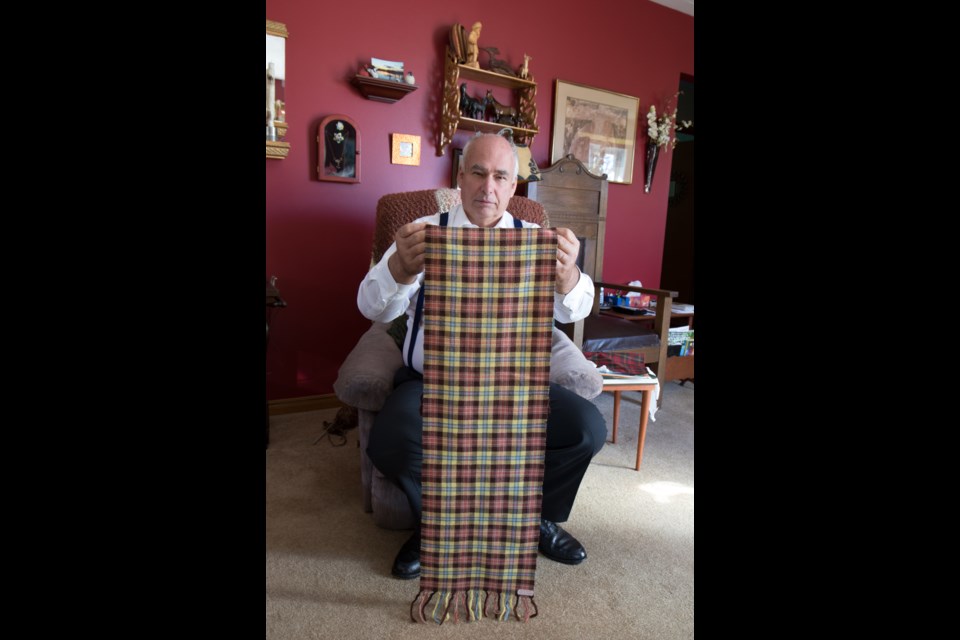Timmins’ very own tartan was almost lost to history, that is, until a group of local enthusiasts saved it.
The Porcupine Tartan, as it is called, was patented in 1956 by local weaver Eva Connor as symbol to represent the Porcupine Gold Mining Camp.
An original description of the tartan’s symbolic colours by Connor was printed in local writer and amateur historian Diane Armstrong’s book, Over the Hill II.
Each of the nine colours represents a natural resource or tradition on which the area was developed, on which it is growing and progressing or which means future prosperity. Gold represents the ore worth a king's ransom about which the Porcupine district was developed. Red stands for the royal emblem of Ontario. Brown and Beige is for the lonely porcupine after which the district was named. Green is for the productive forests of pulp and timber. Grey represents the clay belt of rich agriculture. Blue is for the clear lakes, rivers and streams. White is for the rich asbestos deposits and the Fleur de Lis, a tribute to the French Canadian whose toil helped open up this country.
Those involved with bringing the tartan back have declared that definition outdated, and so today the nine colours – yellow (or gold), red, brown, beige, green, grey, blue, and white – are said to simply represent the area's ‘vast natural resources and diverse ethnic community’.
At the time it was enthusiastically adopted by the Porcupine Chamber of Commerce and the pattern became a short-lived sensation.
Local weavers, including Connor, took to making the actual fabric that ended up in a variety of clothing designs and items.
Scarves, neckties, and bow ties are known to have been made and items like these were actually presented to visiting local dignitaries including Prime Ministers Diefenbaker and Lester B Pearson, and Ontario Premiere John Robarts.
There is said to be at least one dry cleaners who would stitch the tartan onto little cards and put in them in the pockets of suits and a person could then use it as a pocket square (the little bit of fabric that sticks out the chest pocket).
The original meaning of the tartans colours were also printed on these cards.
There may have been some kilts made as well, though it is believed very few.
The tartan was officially registered in Scotland and is said to be the third registered-tartan in Canada; registered after the tartans of the Royal Canadian Air Force and the province of Nova Scotia.
So, for a period of time, the tartan was very popular.
Shortly after its creation, Connor moved to Calgary and the tartan became lost to history.
“It really went big in 1956 then there was nothing and no one really remembered anything about it,” said Diane Armstrong, local writer and amateur historian and who is the one that is credited with bringing the tartan back into the limelight.
Armstrong and her husband actually bought a Porcupine Tartan ties in the 50s from a local weaver but she didn’t really think much of them for years.
In 1998, Armstrong came across them at her home and that discovery piqued her curiosity about the ties origins.
Her curiosity sent her on a four year journey, contacting people across four continents, and writing countless letters, including “letters to the editors of every single northern Ontario newspaper” hoping to get any information she could.
An important moment on her quest was discovering a 127 x 28 cm (50 x 11 inch) scarf in the home of Bryon Millar.
Millar inherited the scarf from his father who was at one time the Reeve of Whitney Township (a position that was something like a mayor).
On Millar’s scarf is attached a little tag that reads ‘Hand Woven, Mrs. E. Connor, Timmins, Ont.’.
Millar’s journey next took her on trail of names and rumours that eventually connected her with Connor’s still living daughter Shirley Boyce in 2002.
This year, Armstrong, librarian Karina Miki Douglas-Takayesu, and Marnie Lapierre of the Northern Ontario School of Scottish Dance thought it would be wonderful to officially bring the tartan back and actually get it made.
On September 20, the trio approached council asking them to adopt it as an official emblem of the city.
They received permission from Boyce, the current patent holder, to change the official description of the colour symbolism to the single line as well as to reproduce the tartan.
“I was very surprised when I got the call (from Armstrong) in 2004. I hadn’t heard from anyone in Timmins in years. I was very pleased that somebody was going to do something about my mother’s tartan. I am terribly pleased to think my mother is getting recognized now. She was a master weaver and good lady,” said Boyce, who’s now in her eighties and living in Calgary.
Boyce said her mother was a shy person who perhaps wouldn’t know what to do with all the attention her work is receiving today.
“It’s inclusive, you don’t have to be Scottish or Scottish descent to wear it. It’s a point of pride and certainly a great conversation opener. If someone were to have this tie they would say, well what is that tartan and what clan is that, where is it from, and what does it symbolize and we can say with pride that this symbolizes the Porcupine Camp,” said Douglas-Takayesu during the council presentation.
The idea was largely met with positive comments from councillors.
“We’re always looking for corporate gifts… that tie looks great with denim, which is important to us,” said Councilor Noella Rinaldo.
“Judging by the positive feedback around the council that, although we haven’t seen it in a while, I don’t think it’s the last we’ll see of the Porcupine Tartan,” said Mayor Steve Black.
